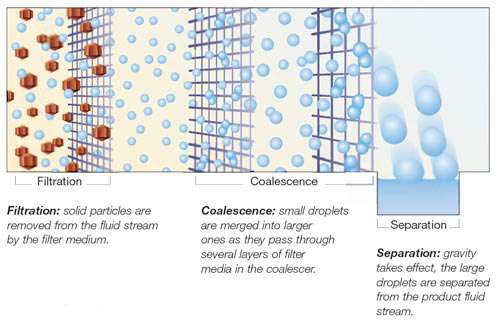Order Products
1/EA
1
4/EA
4
1/EA
1
1/EA
1
Water and particulate contamination in fuel or fluid can cause fouling and equipment corrosion, leading to reduced component life and expensive maintenance costs. Additionally, today, it's essential to recover and process the 'waste' fluids from the process.
Coalescers help separate immiscible liquids (Liquid/Liquid Coalescer) or liquids from a gas stream (Liquid/Gas Coalescer) and keep fuels and fluids free from particulate contamination and free water. Pall offers a wide range of coalescer products compatible with a broad range of liquids and gases for a variety of applications, including HF refinery alkylation, amine systems, caustic treatment, midstream acid gas, LNG acid gas, and much more to save cost and extend equipment life.

Pall’s coalescers effectively filter in three stages:
In normal glass fiber coalescers, the surfactants ‘coat’ the medium's surface, leading to disarming that reduces separation efficiency by decreasing the medium's coalescing properties. Pall’s coalescent filter material consists of polymeric media that is free from glass fibers and is less prone to disarming in the presence of surfactants. This property enables it to offer a longer life compared to other glass fiber coalescers.
Pall’s coalescing filters provide several benefits, like:
Pall's Liquid/Liquid Coalescer separator can efficiently separate liquid-liquid emulsions in oil, gas, and chemical industries. It helps businesses with extended equipment life, reliable operations, and reduced overall cost to offer products that comply with specifications. The Liquid/Liquid Coalescer uses high-efficiency separation with a polymeric material to break emulsion into two phases. The coalescer element can take care of very low interfacial tension (IFT) and doesn't disarm with surfactants.
Pall's PhaseSep coalescing filter can virtually separate any liquid-liquid emulsion.
Pall's AquaSep coalescer effectively separates water from the hydrocarbon stream at lower cost.
Specifically designed for critical air or gas service applications, Pall Liquid/Gas Coalescers filters offer high-efficiency removal of water or oil droplets and particulate solids.
The coalescing filters capture the droplets using a series of graded non-wettable media and coalesce and drain them to the bottom of the housing. They prevent re-entrainment of the filtered droplet into the downstream gas flow.
Pall’s Liquid/Gas Coalescers filters protect downstream equipment and processes from water, compressor wear products, lubrication oil, or other liquid droplets, corrosion products, and other particulate contaminants and reduce maintenance costs.
Pall’s SepraSol coalescers provide high-efficiency liquid and solid removal from contaminated gases, reducing maintenance and operating costs. A patented chemical surface treatment enhances the drainage properties of coalescer element, leading to improved performance allowing for smaller systems, lower pressure drop, and improved ability to recover from liquid slugs.
The SepraSol Plus media can process several times more liquid per unit area of media than conventional media and often eliminates the need for upstream bulk separation equipment like mist eliminators and vane separators.
The SepraSol Plus media is supplied in a large flow, high-performance 6-inch diameter cartridge that can economically treat large gas flows in applications that require a high degree of protection from both solids and liquids.
Pall’s Medallion coalescers is designed to offer enhanced process performance by providing reduced operation and maintenance costs.
Pall coalescer are used in various industrial applications that need to remove particulate matter, water, and other liquids. Some of the applications of Pall coalescer System include:
Pall’s coalescer offers lower separation, operation, and maintenance costs. These coalescers efficiently separate water, fluids, and particulate matter and reduce costly corrosion problems in downstream equipment besides preventing catalyst deactivation in downstream processes. These filters eliminate the need for emulsion-breaking chemicals.
As Pall’s coalescers don’t disarm, they offer extended service life and eliminate ongoing labor costs. These filters come with a high-performance design that leads to a smaller assembly size.
Pall’s coalescers’ filter material is free from glass fibers making them less prone to disarming in the presence of surfactants and providing a longer life than other glass fiber coalescers.